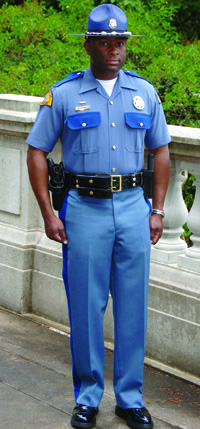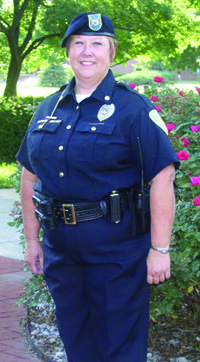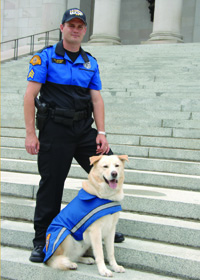|
A sampling of those entered in the recent Best Dressed Law Enforcement Competition, sponsored by the NAUMD, suggests that above all todays police departments are seeking quality quality in appearance, performance and product. Some are even willing to pay a premium to achieve it. But what exactly is considered quality, and what role does value play in determining it? Moreover, can quality be obtained at all price points? For the police customers of Nye Uniforms, quality is defined by durability. Theres a desire for a return-to-basics approach to uniforming, says sales representative Bill Ricard. Departments are shunning some of the trendier styling options in favor of better-quality fabrics in heavier weights. Were now selling pants in a heavier fabric weight than we have in the recent past, and were seeing an upswing in requests for blended fabrics, particularly Dacron/wool and poly/rayon, which are not only durable but look better longer. Ricard credits todays police recruits with the push for quality. Many police candidates have military experience, notes Ricard. Theyre technologically savvy, and theyre used to quality stuff. A Trend Toward Blends Take the case of Independence, Mo., Police Department. A highly visible agency, it was experiencing fit and consistency issues before it turned to Alamar Uniforms. They came to us looking for a quality product, which of course means garments made from wool or poly/wool blends, says Steve Zalkin, owner of Alamar Uniforms. Although more expensive, the department knew that these fabrics would hold up over time, actually saving money in the long run. Michael Bucks of Red the Uniform Tailor (RTUT) adds, What departments are really looking for is value, and value is defined by fit, service and fabric quality. Price comes into play, but if they perceive value, theyre willing to pay more. The Rowlett, Texas, Police Department, too, had fit and consistency concerns when it approached RTUT. To ensure the vertical color match the department desired, RTUT decided to stock dye materials in the chosen midnight blue rather than piece dye garments. The uniforms, too, are made to measure and constructed of 55/45 percent Dacron/wool. Wool in Texas? Wool is a natural fiber and therefore has the ability to breathe, reminds Bucks. Thats a necessity in the Texas climate. Although the custom program has greater up-front costs, the department is actually realizing a savings because it is not replacing items as often. Industry experts say there is a great misconception surrounding contemporary wool products. Most departments associate it with the heavy, itchy wool fabrics of the past, but todays wools are constructed differently and are even washable, cutting down on expensive dry cleaning costs, making its selection a viable option for many, says Roger Heldman of Blumenthal Uniforms. We have to do a better job of communicating this to our customers. Where image is paramount, high-end blends reign supreme. Heldman notes that some of the performance features found in the consumer market can be incorporated into police uniforms, giving the outfits the comfort that officers insist upon without compromising image. He cites his customer, the Washington State Patrol, as an example. They want a traditional appearance, but they are also eager to take advantage of the latest in trimmings and design, he says. As an independent dealer, were able to show them all available options and to provide the customization they seek. Quality at All Price Points The answer is an overwhelming yes, but with some caveats. Bucks says, The industry has been flooded with poly/cottons, and many departments equate the blend with comfort, but what they may not realize is that cotton will eventually fade, compromising appearance. You just cant get a quality look with the fabric. Zalkin recalls one department that, although advised against it, recently made the switch from an all-polyester uniform to a poly/cotton blend. They did a short wear test, not long enough to gain tangible results, he says. After three months and considerable expense, they scrapped the entire program. The uniforms just didnt hold up, and they went back to their all-poly uniforms. For departments with budget constraints, or for specialized units such as cadets or campus police, price-friendly polyester can provide quality without breaking the bank. Polyester is an appropriate choice for police uniforms because it is a durable and easy-care fabric and is practical for many types of work assignments, says Zalkin. To achieve quality with this fabric, however, it takes attention to the details. Zalkin says, Are there military creases in the shirts? Is there double-needle stitching? The quality comes in the manufacturing process and in the service provided by the dealer. Were really talking about value added. This is what the customer looks for, and this can affect quality. There are those who believe that cotton, too, has its place in the police market. Yes, cotton will fade, but weve developed treatments that will slow the process down, says Steve Gilkeson of Perfection Uniforms. For certain types of uniforms, particularly tactical, poly/cottons may be the appropriate choice. A vs. B Uniforms: Class War? Tom Ames of Blauer Manufacturing says, Our tactical uniforms offer the best of both worlds. Blauer, largely credited by industry executives with the creation of the present day tactical uniform, manufactures the widely successful StreetGear line. The trousers and shirts offer the tailored appearance of a dress uniform but have the performance features necessary for todays active officer. Trousers have a stretch waistband and functional side pockets that recall traditional Class A styling, and shirts are designed with a more contemporary and functional yoke design, Ames says. The garments are available in a variety of blends including poly/rayon, poly/wool and poly/cotton. Ames insists that quality can be delivered at all price points. We have a good-better-best mentality here at Blauer, he says. Much of a garments quality comes from the way it was manufactured. Even with standard fabrics, there are a variety of quality features you can add without breaking the bank.
|
|
| Above story first appeared in MADE TO MEASURE Magazine, Spring & Summer 2008 issue. All rights reserved. Photos appear by special permission. | |
| Halper Publishing Company 210 Skokie Valley Road, Suite #4 Highland Park, IL 60035 (877) 415-3300 Fax (847) 780-2902 [email protected] |
|














